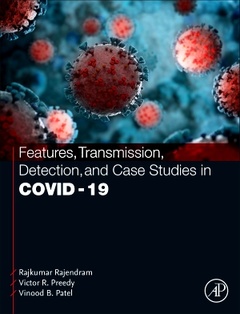Features, Transmission, Detection, and Case Studies in COVID-19
Coordonnateurs : Rajendram Rajkumar, Preedy Victor R, Patel Vinood

Preface I. SARS-CoV-2 and COVID-19: Introductory chapters and setting the scene 1. Coronavirus Disease 2019 (COVID-19) pandemic in context: Systemic effects 2. Early warning signals of SARS-CoV-2 infection 3. Mobile phones and their use to study dynamics of COVID19 pandemic II. Structure, transmission and avoidance 4. Cis regulatory elements: A novel communication route between the host cell and SARS-CoV-2 genome 5. SARS-CoV-2 ORF8: Structure, Evolution, Molecular Function, and Its Contribution to the Pathogenicity of the Virus 6. SARS-CoV-2 Spike Protein Binding Ligands and Its Application in COVID-19 Therapeutics. 7. Autophagy and COVID-19 8. The Omicron variant of SARS-CoV-2 9. Monitoring SARS-CoV-2 spread in hospitals 10. Computational analysis of mutations in SARS-CoV-2 variants spike protein and protein interactions 11. Airborne transmission of SARS-CoV-2 12. Reducing transmission of SARS-CoV-2 with face masks: its potential protective effects 13. Digital twin of ventilation system against COVID-19 transmission and infection risk 14. SARS-CoV-2 infection and transmission in pets 15. SARS-CoV-2 transmission in dental practices 16. SARS-CoV-2 compared with influenza and respiratory syncytial virus in terms of vertical transmission 17. Reducing droplets and aerosols in the surgical setting and applications to the COVID-19 pandemic 18. SARS-CoV motion dynamics: linking in droplet size 19. Ventilation and airborne particles in classrooms: implications for the COVID-19 pandemic 20. Environmental SARS-CoV-2 transmission and e-cigarette aerosols III. Impact and Effects 21. The Impact of COVID-19 on First Responders 22. COVID-19 and suspected drug-induced liver injury 23. Pulmonary fibrosis in COVID-19 24. The effect of SARS-CoV-2 infection on cancer: clinical correlation and potential pathological mechanism 25. Severe SARS-CoV-2, platelet-endothelium interactions and cardiovascular damage 26. Cardio-metabolic Syndrome and COVID-19: Pathophysiological aspects 27. COVID-19 and Type I and II diabetes: an overview 28. COVID-19 and older adults: an overview 29. COVID-19 and male fertility: an overview 30. COVID-19 and obesity: an overview IV. Treatments, strategies and vaccines 31. COVID-19 vaccines and their impact: an overview 32. Exploring the Promise of COVID-19 Vaccines: A Review of Preclinical Studies 33. Drugs actively being investigated for use in COVID-19 34. The biology of neutralizing antibody cocktail therapy with REGN-COV 35. The intensive care unit and percutaneous tracheostomy in COVID-19 36. Cardiac effects of drugs and vaccines used to treat or prevent COVID -19 37. COVID-19 Pandemic and isolation: impact on sleep 38. Strategies in the COVID-19 pandemic: Disinfection of gloved hands 39. In silico studies on established antivirals on SARS-CoV-2 RNA-dependent RNA polymerase 40. The COVID-19 cytokine storm and its immunomodulatory treatment 41. Safety and efficacy of nebulization for reducing the intensity of viral load and clinical manifestations in patients with COVID-19 V. Detection and biomarkers 42. Bronchoalveolar lavage (BAL) and use in detection of SARS-CoV-2 43. SARS-CoV-2 testing and vaccination among people who use drugs 44. Homocysteine as a biomarker in COVID-19 45. Assessment of smell and taste in COVID-19 46. S-gene analysis: RT-PCR and Sanger sequencing applied to SARS-CoV-2 virus 47. False-negatives in screening for SARS-CoV-2 48. Sample pooling and SARS-CoV-2 assays 49. Biomarkers of Invasive Mechanical Ventilation in Obesity and Metabolic Syndrome VI. Case studies with mini review 50. Hypoxia and heart-lung interactions in COVID-19: The significance of right heart dysfunction and shunt 51. CASE STUDY: Neurology, ulnar nerve dysfunction and COVID-19 52. CASE STUDY: Acute kidney injury and COVID-19 53. CASE STUDY: The detection and treatment of a pneumothorax in a patient with Coronavirus Disease 2019 pneumonia 54. CASE STUDY: Conducting ventilation and airflow studies where airborne outbreaks of SARS-CoV-2 have possibly occurred: preventing recurrence VII. Resources 55. Recommended Resources for the Features, Transmission and Detection of Coronavirus Disease 2019 (COVID-19)
Dr Rajkumar Rajendram is a clinician scientist with a focus on internal medicine, anaesthesia, intensive care and peri-operative medicine. He graduated with distinctions from Guy’s, King’s and St. Thomas Medical School, King’s College London in 2001. As an undergraduate he was awarded several prizes, merits and distinctions in pre-clinical and clinical subjects.
Dr Rajendram began his post-graduate medical training in general medicine and intensive care in Oxford. He attained membership of the Royal College of Physicians (MRCP) in 2004 and completed specialist training in acute and general medicine in Oxford in 2010. Dr Rajendram subsequently practiced as a Consultant in Acute General Medicine at the John Radcliffe Hospital, Oxford.
Dr Rajendram also trained in anaesthesia and intensive care in London and was awarded a fellowship of the Royal College of Anaesthetists (FRCA) in 2009. He completed advanced training in regional anaesthesia and intensive care. He was awarded a fellowship of the Faculty of Intensive Care Medicine (FFICM) in 2013 and obtained the European diploma of intensive care medicine (EDIC) in 2014. He then moved to the Royal Free London Hospitals as a Consultant in Intensive Care, Anaesthesia and Peri-operative Medicine. He has been a fellow of the Royal College of Physicians of Edinburgh (FRCP Edin) and the Royal College of Physicians of London (FRCP Lond) since 2017 and 2019 respectively. He is currently a Consultant in Internal Medicine at King Abdulaziz Medical City, National Guard Heath Affairs, Riyadh, Saudi Arabia.
Dr Rajendram’s focus on improving outcomes from Coronavirus Disease 2019 (COVID-19) has involved research on point of care ultrasound and phenotypes of COVID-19. Dr Rajendram also recognises that nutritional support is a fundamental aspect of medical care. This is particularly important for patients with COVID-19. As a clinician scientist he has therefore devoted significant time and effort into nutritional
- Describes neurological issues caused by COVID-19, including stroke and loss of taste and smell
- Discusses COVID-19 biology, including pathogenesis and transmission
- Outlines biomarkers in the brain associated with severity and disease outcomes
- Features individual chapter introductions, summaries, and case studies to provide comprehensive descriptions of neurological symptoms
Date de parution : 06-2024
Ouvrage de 600 p.
21.4x27.6 cm
Thèmes de Features, Transmission, Detection, and Case Studies in... :
Mots-clés :
COVID-19; coronavirus; stroke; brain hypoxia; virus transmission; Parkinson’s; olfactory system; vaccines; biomarkers



